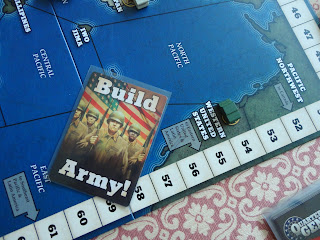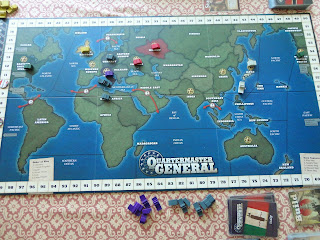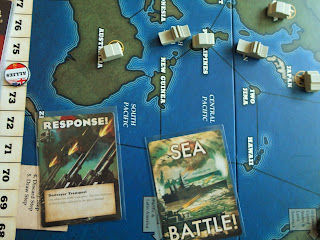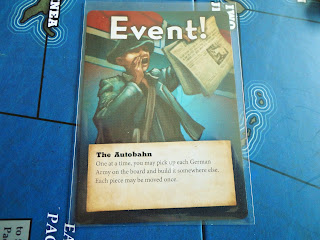This is a review rather than a strategy guide aimed at showing how the game works and my views of the game. As a first play I am sure we did not play an optimal game by any means!
Here is the board and the initial set up with each country just having an army in their home area:
Overview
I will now give a brief overview of the rules and then play through the first couple of turns in full then skip ahead to the heavy action later in the game.
Each player has a fixed set of armies and navies:
- Germany - 7 armies and 3 navies;
- Britain - 5 armies and 5 navies;
- Japan - 5 armies and 5 navies;
- Russian - 7 armies and one navy;
- Italy - 4 armies and 3 navies;
- America - 5 armies and 5 navies.
Pieces don't actually move on the board but show control of an area and then become areas from which actions can be taken like an attack or building in adjacent areas (that are not enemy controlled). You can only have one piece in a space but there can also be a piece from anyone else on your team. Mostly actions can only be done from an area if it is supplied - that means tracing a continuous line of areas with your units in back to a supply base. Navy units also need to have a land unit in an adjacent area but that can be a unit from another country on your team (represents an open port). One distinction which is important is that units can be built or with some card effects can be recruited. A build can only be done if the unit would be placed and in supply immediately but with recruiting it can be put on the board regardless of supply. There are examples later on showing why this is important.
The turn order is:
- Germany
- Britain
- Japan
- Russia
- Italy
- America
and a turn consists of the following:
- Play a card (only one card);
- Check supply;
- Collect victory points;
- Discard cards if you wish;
- draw back up to seven cards.
Victory points are gained for supply areas (star in a circle) with 2 points for each controlled and then points for some card effects.
The cards
So you can see just from the turn sequence that it is all about card play. As an introduction to the cards let's consider my set up as the Germans. Each player shuffles their country decks and then deals 10 cards for each but has to discard 3 and keep 7 for their starting hand. Her are my first 10 for Germany:
Having not played before I am trying to make a decent choice based on the type of card and the effect and what I think I will be trying to do as my strategy.
First let's consider the status cards. My opinion is that these are some of the most powerful cards if the ability is a good one that fits in with what you are trying to achieve. The reason for this is that when played they stay face up on the table and the effect is there for the rest of the game - it may be a continuous effect or a triggered ability. Given only one card can be played a turn something that remains to be used is a big increase in what you can do on a turn. If you click on the photos you will get a larger picture and you can read the cards, but in summary I got:
- Abundant Resources - get a victory point if occupy Ukraine. I didn't think this was sparkling card but kept it anyway as I would definitely be looking to take and hold Ukraine so should come into effect. Actually after the first couple of turns I realised the odd extra victory point a turn can be important to not fall behind assuming an automatic victory does not happen (400 VPs or capture two opposing home areas) - although as it turned out I did not play it as too many other better choices when it came down to it;
- Volksturm - allows Germany to use a land battle card to take back Germany where otherwise the units would be out of supply and unable to be used to play an attack card. I thought this was a bit defeatist and did not keep;
- Jet Fighters - puts a penalty back on the opposition if they play an economic warfare card on you. As I was expecting this to be something the Allies would do this seemed a strong card;
- Bias for Action - when building a unit in an area you can discard the top card from your deck to then attack an adjacent area (attack meaning remove a unit from the adjacent area). This seemed very strong and so a definite keeper.
Germany is quite heavy in status cards by the way which is why they can act like the actual Germans and spread quickly.
I had a couple of economic warfare cards. These allow you to deplete opponent's decks by forcing discards from the top of the draw pile. Not sure at this stage how good this is but knowing various card games and depleting decks being powerful I thought carefully about these. Having decided not to go naval with the Germans I discarded the one against Britain as I would need a fleet but kept the one that targets Russia.
The basic cards that each player has are:
- Land battle - remove an enemy piece from a land area adjacent to one of your supplied pieces (your piece can be a navy hence amphibious landings);
- Sea battle - the same but for attacks on a sea area (your piece can be army or navy - I guess attack from a land area is representing air attack?);
- Build army - put an army piece in a land area, adjacent to one of your pieces, that does not already have one of your pieces, or an enemy piece, and would be in supply when placed;
- Build navy - as above but navy piece in a sea area.
I decided to keep both land attack and the build army but discard the build navy card. And here is my starting hand.
Just a word on two other card types that did not appear in my starting 10 for Germany:
- Event cards - these provide a one off result when played and are quite varied in what they do. You will see a few during the course of the play through;
- Response card - like status cards these are played in front of you to be used later. The difference being they are placed face down so your opponent can't see them. They are also come into play when triggered and then discarded so just a one off. Despite being a one off they are a surprise and can do things like place other pieces or prevent your pieces being removed so quite powerful. Japan has quite a few of these and not may status cards. You will see some examples in the play through.
So on to the first couple of moves which will hopefully make the game mechanic clear.
Turn 1:
Germany places the status card Bias for Action. Essentially getting ready for later turns when a build action will become more powerful. Gains 2 VP.
Britain plays a status card that allows units to be built directly in India. While India is a supply area it only acts as one when a unit is on it and hence initially you would have to trace back to the UK to be in supply without this card. Gains 2 VP.
Japan had a lot of cards for building so built a navy next to Japan first. Gains 2 VP.
Russia builds an army in Ukraine. Gains 4 VP.
Italy play an event card which recruits a German army in North Africa and a navy in the Med. The placement of the units is a recruit not a build which is important as the units would not be in supply - but don't have to be checked until the German turn after card play. A reminder, a built unit has to be in supply when placed a recruited unit does not. Gain 2 VP.
The Americans build and army in the Western US and gain 4 VP.
Map after turn 1:
Turn 2
Germany builds an army in Western Europe. This was not because it was vulnerable to attack - until the British have a navy in the North Sea they can't place armies there. But it was to complete the supply lines for the fleet in the Med and the army in North Africa. It also was a side benefit to stop the Allies getting miles ahead on VPs as two of their countries where gaining 4 VPs a turn. Gain 4 VPs.
Britain builds a navy in the North Sea. Gain 2 VPs.
Japan builds an army in China. Gain 4 VP.
Russian builds an army in Khazakstan - I would probably have gone for Russia personally (keeps it from being adjacent to the Germans but builds up blocks to Moscow). Gain 4 VP.
Italy places down a reaction card - Romanian Reinforcements which you will see later. Gain 2 VP.
The Americans build an army in Latin America - this was to allow a British fleet to be built in the South Atlantic on a later turn. Without the army there would be no port and hence not in supply and can't be built. As it turns out later this was not a great move as the supply line was too vulnerable particularly with the lack of appearance of an American navy. Gain 4 VP.
Skipping forward a bit, things got really interesting on turn 7:
On the German turn an Event card, Broad Front, was played. This allows the Germans to attack up to 3 Russian armies that are adjacent (and attack means remove). There are only 2 adjacent - in Eastern Europe and Ukraine but still a good attack.
By now the Germans have 4 status cards out and 2 are really nice and interact very well: Blitzkrieg which allows a new army to be placed in an area you have just battled and Bias for Action which allows the Germans to battle a new area adjacent to a newly built army. Both require a card to be discarded from the top of the deck. Not only can the playing of a card trigger one of these they then trigger each other and either way round too.
So this is how it all worked out. Broad Front removed the Russian armies in Eastern Europe and Ukraine. Blitzkrieg then kicks in from an attack and I chose the attack on Ukraine (can only do once a turn). That builds a German army in Ukraine and the build then triggers Bias for Action which attacks Moscow and removes the unit (can't trigger Blitzkrieg a second time to occupy it unfortunately!). However, the Russians still have one face down response card which they trigger - Moscow which prevents the removal of an army in Moscow for that turn.
Meanwhile in the Far East the Japanese take the opportunity presented by a lack of a British unit in Australia. In a previous turns the Japanese had put a fleet in the South China Sea and also put face down some response cards, one of which was Destroyer Transport. The card played for the turn was Sea Battle and it is perfectly legitimate to battle an empty area to trigger effects (the rules specifically state this). So I made a sea attack into South Pacific then used that to trigger Destroyer Transport which allows you to put up to two armies on the board adjacent to the attacked area. I used that to put an army in Australia but decided not to put one in New Guinea as I wanted my limited pool for China and there were no Americans in sight to defend against anyway.
The Italian turn really started in the Russian's turn. The Russians attacked Ukraine to remove the German unit and hence push them back from Moscow. However, the Italians had a response card down which then triggered: Romanian Reinforcements which triggers when a supplied German unit is removed and replaces it with an Italian Army (recruit). At that point the Italian army is not in supply as it can not trace a line of Italian units back to Italy but supply is only checked in your own turn and after card play. Hence, in the Italian turn I played Build Army to put an army in the Balkans to keep the army in supply for the next step when supply is checked.
Turn 8, conquest of Russia:
This is the position at the start of the German turn with no German armies adjacent to the Russians but the Germans doubled up with the Italians in North Africa and the Balkans. So the potential to continue the conquest looks a bit tricky.
However, I have the event card The Autobahn in my hand. That allows me to pick up every German army and build elsewhere (if I so wish). I decide to do that with the army in North Africa and the Balkans and move them to Eastern Europe and Ukraine.
Because the event card does not move the unit but removes and then builds elsewhere the build allows Bias for Action to trigger and for Moscow to be attacked from Ukraine. With the Russians all out of response cards Moscow is cleared and Blitzkrieg can be triggered to build a German Army there. The Russians no longer have units in supply so the ability to play cards is limited and they get removed in the Russian supply phase.
Before seeing the conclusion of the game a brief look at the American cards. Four status cards are out. One allows the use of the supply base in Szechuan (and hence can build units there not just trace supply), another a second fleet can be built when building one and a similar one for armies and the last one being the ability to bring back a card from the discard pile by discarding 4 from the top of the deck. Other than preventing Japan expanding in China the first did not affect things very much. The extra builds were not much use as the Americans only have 5 army pieces and 3 were already out and having never drawn a build navy card the US fleet didn't make an appearance (a few came up when discarding from the top of the deck but none in hand). The last status card was used a few time to bring back an economic warfare card that forced the discard of 4 cards from the top of the Japanese deck - so just as well they did not need to do anything much once Australia was captured. So all in all the Americans did not really impact on the war. I am not sure if a build navy card was discarded in selecting from the initial 10 cards - I forgot to ask - or it was just horrendous luck that they were discarded for card effects every time one came near the top. Just realised that Flexible Resources could have been used to bring back a build navy card then Superior Shipyards to build a second one - which could have got a fleet into the North Sea in one turn. Whether it would have been enough as the Italians had a second sea battle I don't know but could have made a difference.
End of the War
As the Germans took Moscow, the Italian fleet attacked the British in the North Sea. The Brits had no Response cards to prevent it and the next turn did not have a build navy card to hand to build in the empty sea area. The British navy in the South Atlantic and the army in Africa were removed because of supply. This allowed the Italians to build a navy there on their turn (the British used some affect to destroy a fleet in the Med - can't remember precisely what - but with a German fleet there I could lose that and still have an Italian fleet remaining to ensure I could then build in the North Sea because it would be in supply). The following turn the Germans built a fleet in the North Sea then the turn after attacked the UK and with Blitzkrieg could place a army there so no time for the Brits to build on the empty space (you can always build on your own home area if not occupied). Game over with two enemy home areas occupied on turn 11 (out of max 20).
Conclusions
Excellent game. It is actually a card game with a board rather than the other way round I would say. I don't agree with the assertion in the rules that it is a game of supply. While supply is important you are not doing anything with supply in the game other than ensuring all your units are connected and can trace back to a supply base - and hence and be used for the launch of an attack or to allow a build in an adjacent area etc. It is more a game of preparation and build up and making the best use of each country's abilities - which are a different mix of status and response cards (mostly status for Germans and mostly response for the Japanese for instance). In this way you get the most benefit from actions like build or attack or blunt your enemy's actions. You also have to accept giving up cards as discards to power many of these benefits - so you need to be sure you are doing something worthwhile as a really good card could be lost. Each action you take should build towards your goals - no point just building units on the board for the sake of it unless it takes your strategy forward. Getting cards that interact well is pretty important too.
Works very well as a two player game. I have not tried other numbers of players but I can't see any issues with any of the possible numbers - even the Italians are good to play having so many supporting cards for the Germans rather than having to do their own thing all the time. With multiple players you still only win as the Allies or Axis so that may not suit some people as there is no individual winner except in the two player game (or possibly the single team in the three player game). However, all player will be doing things that obviously contribute to the win so I suspect it is still a fulfilling experience for all.
It is a relatively quick game and will speed up as you get the hang of the cards and the general strategy. I can see me playing this many times (I also have the expansion Air Marshal but will bring that in later rather than straight way, will just add to ongoing re-playability). Games will certainly improve as the understanding of how cards interact develops as well as finding alternative ways to get things done rather than just the obvious way. But also knowing what it is important to do and when.
A WW2 game that is really about supply is Road to the Rhine which I have and have played as one, two and three player and this is also a good game which I may do a review on at some point.
If you like Napoleonic board games then my review on W1815 me be of interest too.





























Great review. Am keeping an eye out for a copy.
ReplyDelete